| | 07/13/2016 | 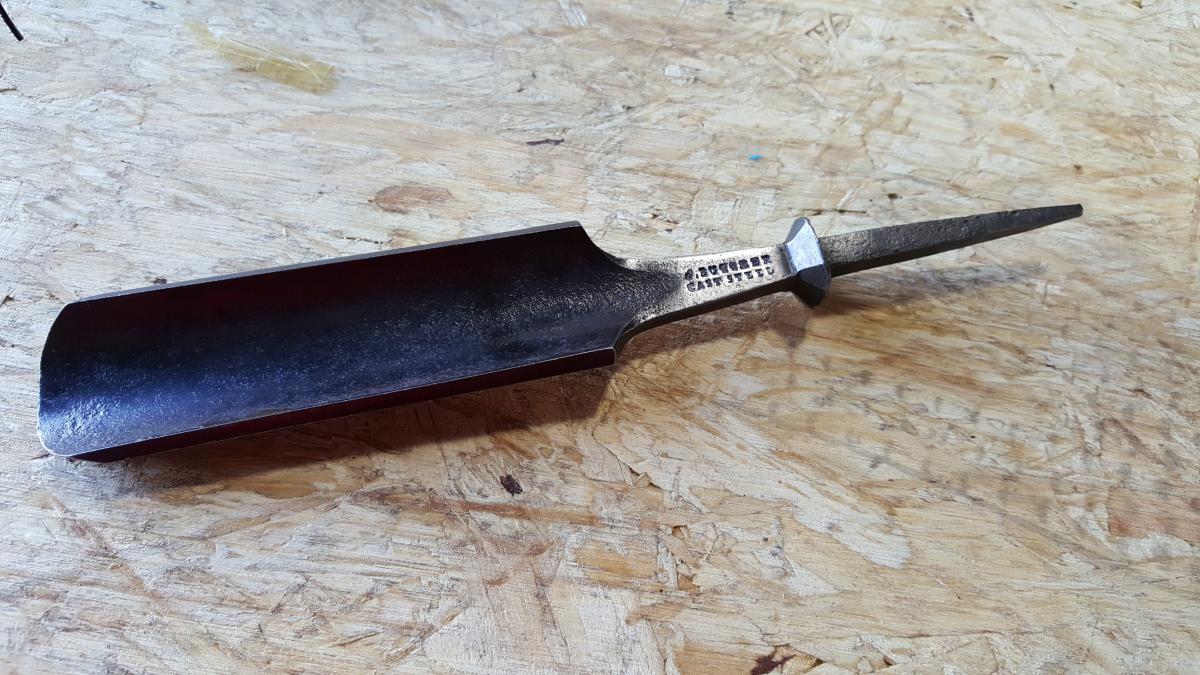 Earlier today a I was handed this tool - by a guy who found it in a basement and had no use for it. Earlier today a I was handed this tool - by a guy who found it in a basement and had no use for it.
What can we determine by looking at it?
My first impression, because of the tool's rounded nose, was that it was a turning tool. But it's not. It's too short -- which of course could just mean wear. The dead giveaway, however, is the bolster. Bolsters exist so that hitting a handle with a mallet doesn't cause the tang to drive further into the handle. In the days before ferrules (pre-1850) bolsters were wide and essential for preventing splitting the handle. Post ferrule introduction, bolsters were largely (but not entirely) redundant, and they got smaller and smaller. Turning tools, which aren't struck, don't need bolsters and therefore don't have them. So this tool is a gouge of some sort.
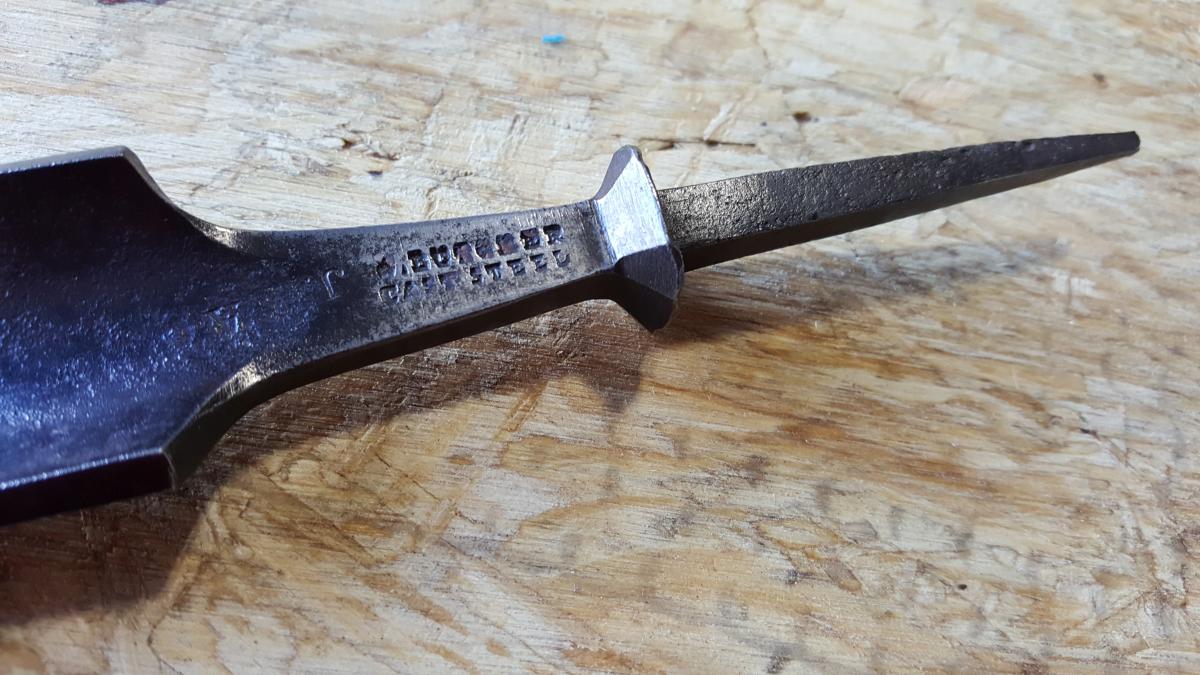 What kind of gouge? It's not a carving tool. The lines of the tool are wrong, and the curved grind in front it pretty useless for carving. It's a firmer gouge used by cabinetmakers. The curved nose makes it easy to shave off bits of wood to a line precisely. What kind of gouge? It's not a carving tool. The lines of the tool are wrong, and the curved grind in front it pretty useless for carving. It's a firmer gouge used by cabinetmakers. The curved nose makes it easy to shave off bits of wood to a line precisely.
The octagonal bolster, which is in very good shape and is pretty crisp, tells me that the tool is probably from the 19th or early 20th century. (I need to check the maker to be more specific). I'm also struck by how gracefully the neck tapers down, is interrupted by the bolster, and then picks up and continued on the tang on the same lines. The bolster was forged in and finished up with a file.
The front of the tool bears the maker's stamp (Butcher) and the back is the trademark. I haven't been able to track down details on the maker. I think I have more information on Butcher -- but the information is my library, just about the only part of TFWW's move that hasn't been unpacked. A book I need is in a box, on a pallet, on a rack twelve feet up in the air.
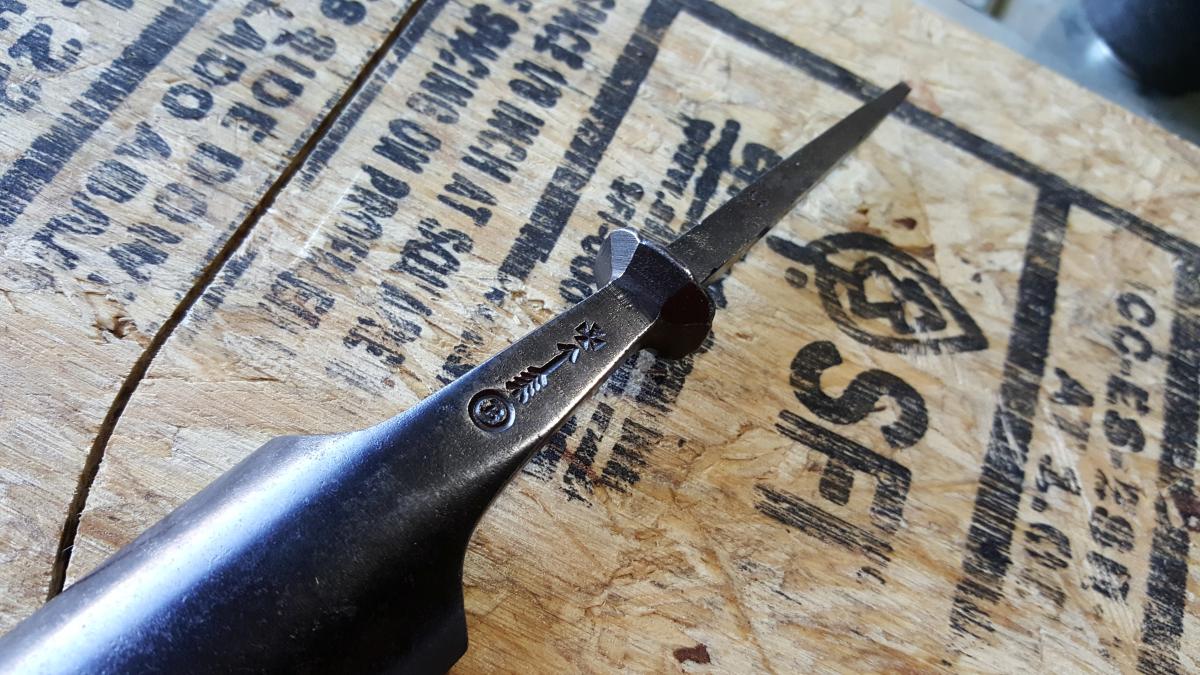 The front also bears a faint stamp, from either the retailer or the user. I'm a little confused by it. That part of the tool near the neck would be hardened but not so much that a stamp would not work. The deep maker's mark and brand were stamped when the tool was finished but not hardened. The front also bears a faint stamp, from either the retailer or the user. I'm a little confused by it. That part of the tool near the neck would be hardened but not so much that a stamp would not work. The deep maker's mark and brand were stamped when the tool was finished but not hardened.
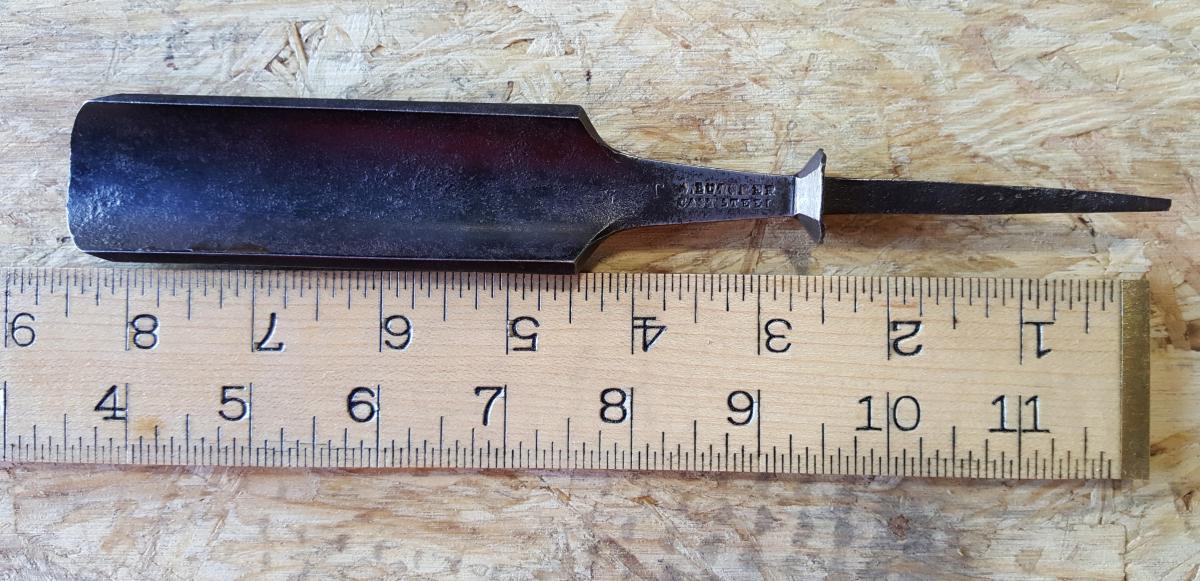 If we look closely at the cutting edge, we can see that it isn't perfectly curved and is worn a bit at the center. If you look carefully, you can see faint grind marks. This tool was used, but it was carefully used, and properly maintained for most of its life. There are clear grind marks on the neck that suggest that that part of the tool never rusted. The back of the tool has some evidence of putting, which suggest rust at some point but not a lot. The inside of the gouge is clear now but shows lots of pits. However, because the initials are fairly crisp I think the rust on this side was also pretty minimal. The rough inside texture of the gouge might come from pitting caused by rust that was subsequently removed, but more likely - based on the typical practice of the time - the gouge simply wasn't ground on the inside when it was manufactured. If we look closely at the cutting edge, we can see that it isn't perfectly curved and is worn a bit at the center. If you look carefully, you can see faint grind marks. This tool was used, but it was carefully used, and properly maintained for most of its life. There are clear grind marks on the neck that suggest that that part of the tool never rusted. The back of the tool has some evidence of putting, which suggest rust at some point but not a lot. The inside of the gouge is clear now but shows lots of pits. However, because the initials are fairly crisp I think the rust on this side was also pretty minimal. The rough inside texture of the gouge might come from pitting caused by rust that was subsequently removed, but more likely - based on the typical practice of the time - the gouge simply wasn't ground on the inside when it was manufactured.
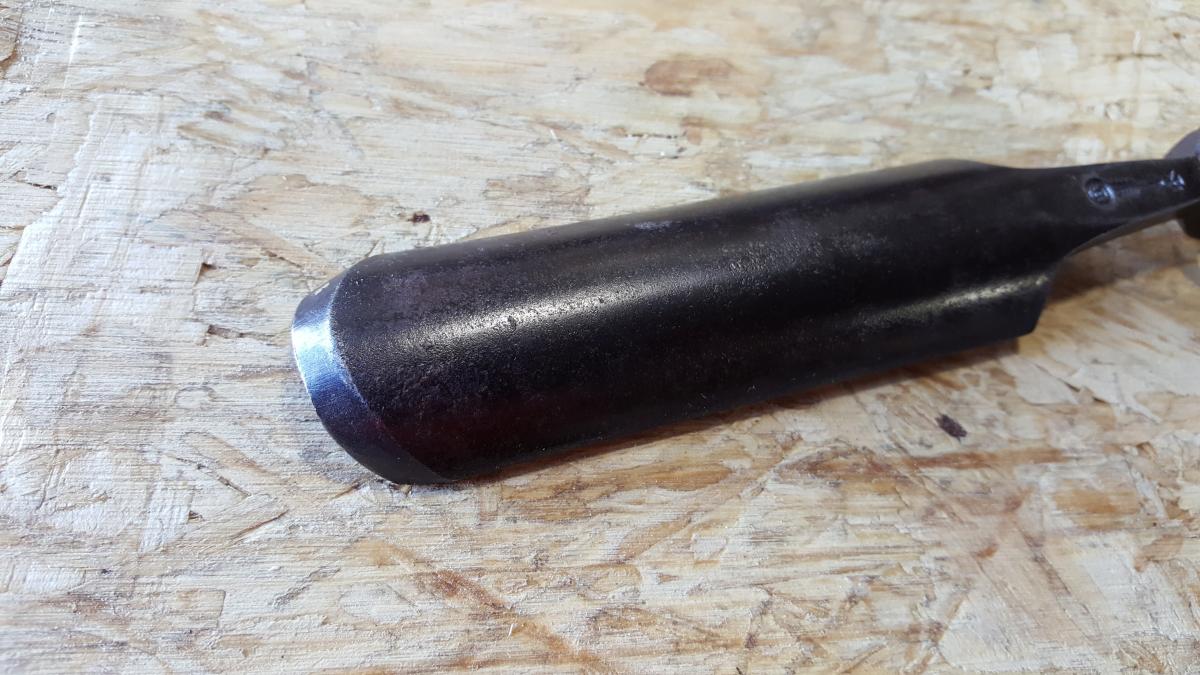
| Join the conversation | |
| The opinions expressed in this blog are those of the blog's author and guests and in no way reflect the views of Tools for Working Wood. |
|
 Joel's Blog
Joel's Blog Built-It Blog
Built-It Blog Video Roundup
Video Roundup Classes & Events
Classes & Events Work Magazine
Work Magazine






















 Earlier today a I was handed this tool - by a guy who found it in a basement and had no use for it.
Earlier today a I was handed this tool - by a guy who found it in a basement and had no use for it.  What kind of gouge? It's not a carving tool. The lines of the tool are wrong, and the curved grind in front it pretty useless for carving. It's a firmer gouge used by cabinetmakers. The curved nose makes it easy to shave off bits of wood to a line precisely.
What kind of gouge? It's not a carving tool. The lines of the tool are wrong, and the curved grind in front it pretty useless for carving. It's a firmer gouge used by cabinetmakers. The curved nose makes it easy to shave off bits of wood to a line precisely.  The front also bears a faint stamp, from either the retailer or the user. I'm a little confused by it. That part of the tool near the neck would be hardened but not so much that a stamp would not work. The deep maker's mark and brand were stamped when the tool was finished but not hardened.
The front also bears a faint stamp, from either the retailer or the user. I'm a little confused by it. That part of the tool near the neck would be hardened but not so much that a stamp would not work. The deep maker's mark and brand were stamped when the tool was finished but not hardened.  If we look closely at the cutting edge, we can see that it isn't perfectly curved and is worn a bit at the center. If you look carefully, you can see faint grind marks. This tool was used, but it was carefully used, and properly maintained for most of its life. There are clear grind marks on the neck that suggest that that part of the tool never rusted. The back of the tool has some evidence of putting, which suggest rust at some point but not a lot. The inside of the gouge is clear now but shows lots of pits. However, because the initials are fairly crisp I think the rust on this side was also pretty minimal. The rough inside texture of the gouge might come from pitting caused by rust that was subsequently removed, but more likely - based on the typical practice of the time - the gouge simply wasn't ground on the inside when it was manufactured.
If we look closely at the cutting edge, we can see that it isn't perfectly curved and is worn a bit at the center. If you look carefully, you can see faint grind marks. This tool was used, but it was carefully used, and properly maintained for most of its life. There are clear grind marks on the neck that suggest that that part of the tool never rusted. The back of the tool has some evidence of putting, which suggest rust at some point but not a lot. The inside of the gouge is clear now but shows lots of pits. However, because the initials are fairly crisp I think the rust on this side was also pretty minimal. The rough inside texture of the gouge might come from pitting caused by rust that was subsequently removed, but more likely - based on the typical practice of the time - the gouge simply wasn't ground on the inside when it was manufactured.
I don't remember the details, but I think the arrow stamp implies that this gouge was made for the British government.
blog on military norris plane
Butcher was a known Sheffield edge tool maker and the cross arrow and circle is their maker's mark - the military mark I think you refer to is the same as our ordnance survey (national mapping) land height mark - like an upside down V with added line across top and dividing line - seen on most tools bought by army up to about 1960s.
I would say this is a fine out-cannel cabinet maker/sculptor gouge "repurposed" as a turning tool (with new grind and maybe with a long handle added) and discarded when too short - this could be why the inside is corroded (always full of shavings, especially if green wood) and the outside not (always been 'cleaned up' by wear on the tool rest. But we can't say for sure unless you find the previous user.
regards from Sheffield
danny
http://contrib2.wkfinetools.com/TweedaleG/Butcher/01-History-Butcher.asp
Their manufactory still stands! Interestingly, the company specialized in export markets and their tools are much more common in the USA than in England. A lot of early 19th-century American plane makers used Butcher irons, until the American edge-tool industry got up to speed.